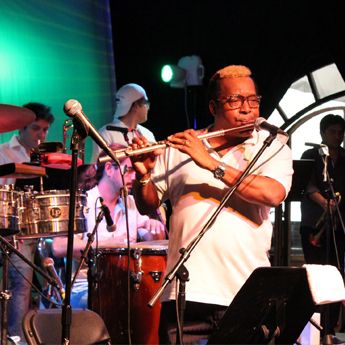
Musical arranger, composer and flutist.
José Luis Cortés was born on October 5, 1951 in Villa Clara, Cuba. At an early age, he showed unusual aptitudes for music and dance. Graduated from schools and institutes of art in Havana, he became one of the first-rate Cuban musicians.
As flute player, he joined important Cuban groups which left an indeleble mark in the musical history of the island such as "Los Van" Orchestra and "Irakere". In 1988, together with other talented musicians, he founded the "NG La Banda" Orchestra, one of the most outstanding Cuban groups of the last decade in the Cuban arena. With its 36 recordings, some of them resounding hits, "NG La Banda" has left an extremely rich legacy to Cuban popular music.
With "NG la Banda", José Luis Cortés introduced a new and vigorous sonority in Cuban contemporary music, as well as a popular way of conveying the texts of his songs. His musical arrangements for the brass section, as well as the performance of the tumb
aos linked with the rhythmic section and the keyboards, have allowed him to create a matchless, distinctive sonority. For that reason, "NG la Banda" is considered one of the most important musical groups of all times.
José Luis Cortés and "NG la banda" have performed at the most renowned European musical centers, i.e. the Frankfurt Salsa Festival, Holland Salsa, The Nice Jazz Festival, The Parls Caribbean Festival, the Salsa Festival in Madrid, the famous Ronnie Scotts jazz club in London and in the Festival de Soneros of Santa Coloma, besides having successfully participated in the Salsa Festival of Puerto Rico and the Festival of Soneros in Santa Cruz de Tenerife.
The NG La Banda orchestra was founded in 1988 by José Luis Cortés "El Tosco" (The Rough), a virtuoso flute player who, as previous member of first-class groups, had accumulated a vast experience from Los Van Van and the Irakere group. Therefore, his main purpose was to create an orchestra which combined both the taste of the first and the musical aggressiveness of the latter.
After leaving the Irakere, José Luis Cortés began an experimental project by mixing the Cuban music with jazz elements which was known, since the very beginning, as the "New Generation" or the "Orquesta Todos estrellas" (All Star Orchestra). Its members came from the Cuban jazz of the 1980`s and, among them, musicians like Gonzalo Rubalcaba, Ernán López-Nussa, Horacio Hernández, Calixto Oviedo and the overwhelming majority of the musicians who, later on, made up the new project launched by José Luis Cortés.
Since its inception, NG La Banda was supported by musicians like Isaac Delgado, who was one of its members during the 1990`s; Giraldo Piloto in charge of percussion, who is currently the director of the Klimax group; singer Tony Calá, who was violinist in the Ritmo Oriental Orchestra and who is still member of NG La Banda; the legendary conguero "Wickly" from the Pachito Alonso Orchestra; Rodolfo Argudín, Peruchín`s grandson; Germán Velazco, who played with the Revé Orchestra; José Miguel Crego, known as "El Greco"; José Murguía, Carlos Averhoff, Feliciano Arango and Calixto Oviedo, among other prominent representatives of the Cuban music. This astounding gathering of talents has resulted in the continuous generation of excellent and daring musical ideas turned into pieces of international reference.
NG La Banda gave way to a new music of multiple influences and experiences lived in the Havana of the 1980`s. In an ingenious exercise of synthesis, José Luis Cortés has been capable of laying the foundations for what is known as Timba by combining the sounds preferred by youth and the impetus of the rumba, the creative freedom of jazz and the Afro-Cuban and foreign rhythms to produce an exceptional sound.
Very soon, the orchestra found a place in the popular preference since its unique proposal was based on a great rhythmic wealth, arrangements of extraordinary precision, first-rate vocalists and an excellent work with the brass section now known in Cuba as "the brass of terror".
Music experts have stated that NG La Banda "sounds as a single instrument and every instrument sounds like an orchestra, a magic attained thanks to the almost supernatural tuning of every instrument".
The recording career of the orchestra has been both prolific and successful since the recording of its first CD entitled "No se puede tapar el sol", which includes pieces rooted in the popular preference as, for example, "La expresiva" and "Los sitios entero" or "Que viva Changó" (an exceptional version of the classic song by Celina González) and "Santa Palabra". Other outstanding hits include "Necesito una amiga" "sang by Isaac Delgado, it was one of the first rapprochement of NG La Banda to the Latin pop- and "Echale limón" and "Murakami Mambo".
The orchestra has performed in the most diverse scenarios in Europe, America, Asia and Africa and its presence is demanded at the most important jazz and salsa centers throughout the world.
For years, José Luis Cortés, with a very good nose for discovering new talents, has managed to renew NG La Banda with excellent singers and instrumentalists without altering the distinctive label of the group.
Today, the orchestra is still one of the leading orchestras in the preference of both the audience and the critic in different parts of the world and is still generating a unique sound characterized by the fusion of Cuban and Caribbean rhythms.
NG La Banda has summarized the best development process of Cuban music in the last four decades when the schools of art, established across the country, have graduated professionals of the highest quality. It is indispensable to mention that most of the excellent music produced in Cuba during the last years has been performed by this orchestra.